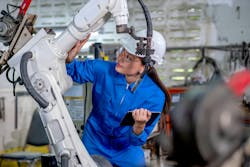Preventative Maintenance for Robots in the Field
- In addition to preventative maintenance, Roboworx’ field service includes staff retraining, robot optimization and environment adaptation to prevent robots from becoming unused assets.
- Roboworx’ Robo Server Manager software gives OEMs complete visibility into their robot fleets, from maintenance scheduling to end-user feedback.
- Roboworx works with robot OEMs to handle field service across the U.S., offering bespoke agreements tailored to each partner's needs.
It’s not often discussed, but robot companies are well aware that many robot deployments often fail within a year due to maintenance gaps, lack of automation assessments and user training issues. Dale Walsh (DW), vice president of strategy and innovation at Roboworx, spoke with Automation World to explain how Roboworx’ preventative maintenance approach helps robot OEMs scale operations, maximize uptime and ensure manufacturers achieve expected ROI from their robotic investments.
AW: Roboworx works with robot OEMs to handle their field service management. Can you discuss which OEMs you work with?
DW: A lot of robot companies don't want to admit that their robots need service. So, we only have a handful we can talk about publicly. For example, we work with a company called Picnic in the food service space. They build robots for pizza assembly. We install, maintain and repair those robots for them. We also work with Richtech Robotics, they do a lot of work in the hospitality space — restaurants, hotels, casinos, airports — everything from delivery robots to floor cleaning robots. They're one of our largest partners.
Essentially, we work with robot companies. Oftentimes, it is the OEM, but not always, and we help them scale. It's really important for smaller startups or established companies coming into the U.S. market to think about tackling robot service across the U.S. It can be pretty intimidating, but by using a partner like us, we take away a lot of that stress for them. And we don’t have to do everything for them as part of the agreement, we have a very bespoke agreement.
We may only handle certain parts of the operations process, like preventative maintenance, which tends to fall to the bottom of the priority list when it really should be at the top because that maintains uptime.
AW: For the maintenance aspects that you handle, is that largely done remotely or on site?
DW: It's on site. We have a partner for remote support if needed. But our focus is principally on on-site support. With most of the robot companies we work with, we do quarterly preventive maintenance checks to perform whatever the manufacturer requires from a preventative maintenance standpoint.
But we also go deeper than that. Robots are typically installed in high turnover environments, so there's a constant need for retraining the staff on how to work with the robots. We also look at how the robots are being used to ensure they’re optimized for the environment. A lot of these places are very dynamic, especially warehouses. So, we constantly work on adapting the robots to the environment and look for opportunities to expand what the robots can do there. It's more than just doing the electric and mechanical repairs. It's also making sure that the end customer is really getting the value that they expected out of their investment.
AW: Are there specific industry trends driving your business at the moment?
DW: Ensuring uptime is the most critical. Unplanned downtime is a killer; that's why we focus so heavily on the preventative side. For one customer, we’ve been able to reduce their service calls by 93% through our regular preventative maintenance program. Before they began working with us, their maintenance process was completely reactive. Our preventative maintenance approach really helps with end user ROI.
AW: We often hear about small to mid-sized manufacturers buying a robot only to have it wind up sitting unused less than a year after purchase. The reasons for this range from a lack of familiarity with robot technology or a failure to assess the impact of robotic automation in their operation to cultural issues. Have you seen this?
DW: Yes, and that's why we built the program the way we did. Most of the time, the people who will be using the robots are not the people who made the decision about the robots. This means they typically don't feel empowered to pick up the phone and call a robot manufacturer to say: Hey, this isn't doing what we need it to do. They just stop using it or build in workarounds.
The people using the robots are not often the people who made the decision about the robots. This means they typically don't feel empowered to pick up the phone and call the manufacturer to say: Hey, this isn't doing what we need it to do. They just stop using it or build in workarounds.
When we're on site for maintenance, we're not only meeting with management, we're also meeting with the end users to find out how the robot is working for them. We look to resolve any issues before they become problems and before the robot gets pushed over to the corner.
AW: Tell us about your recently released Robo Server Manager software, which you say is the industry’s first robot service maintenance optimization system.
DW: We’ve built our own robot management software platform to manage the fleet of robots we maintain. It's built specifically for robotics. So instead of buying an off-the-shelf package and trying to customize it, we built it from the ground up to support the needs of robots in the field in different environments and to support our workflow. It's included with all our robot installs; it's not something the OEMs have to pay extra for.
And it doesn’t matter if they have 50 robots or 5,000 installed with us. It gives the OEM complete visibility as to what's happening with their robots. They know when they're scheduled to have maintenance service and when it happened. They have before and after photos. They have the details of what happened during the install and if any issues were discovered. It also provides for feedback from the end user to the OEM.
Though most of our work is with robot OEMs, we also work with integrators and resellers as well as some large end customers who need a common source of service for multiple facilities with multiple robots. We handle robot services for them through a shared services model.
And I should note here that all we do is robots. We don’t repair or maintain controllers and linear actuators or other automation technologies, just the robots. Most of the work we do today is with mobile robots.
AW: Do you also provide predictive maintenance services in addition to your preventative services?
DW: We’re developing a predictive component in our software tool so that when we’re doing our quarterly preventative maintenance checks, the software will be able to recognize if, say, a motor in the robot is near its end of life. With this information we can determine if we should go ahead and replace that motor or wait until the next service based on what the software indicates. This all goes into our discussions with the OEMs around timing of the replacement.


